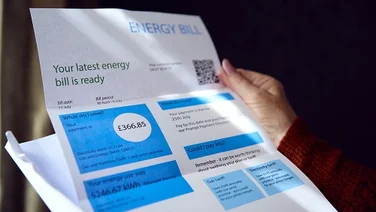✔ He’s cut two climate activists from his cabinet and added a climate denier
✔ The onshore wind ban has been maintained
✔ The Energy Price Guarantee will rise to £3,000 in April 2023
Prime Minister Rishi Sunak became the UK’s third leader of 2022 on 25 October, walking into an economic crisis and ongoing climate disaster.
The former chancellor now has the power to help millions to escape fuel poverty, build a green future for the UK, and create a global coalition to fight climate change.
This is one of the most crucial moments in our recent history, both as a country and a global community.
Here’s what you can expect Sunak to do about your spiralling energy bills, and how he views climate change and green energy.
How will Sunak affect your energy bills?
The Energy Price Guarantee created under former Prime Minister Liz Truss has been retained, and will keep the average annual dual tariff energy bill for the typical direct debit customer in a three-bedroom household at £2,500 until the end of March 2023.
This is still 27% higher than the previous price cap, but it won’t ruin as many lives as the £3,549 price cap that was previously planned.
The Energy Bills Support Scheme has also continued, meaning all households will see their energy bills cut by a total of £400 between October 2022 and March 2023, with higher payments for homes containing disabled people, pensioners, or low-income inhabitants.
Sunak introduced this scheme while he was chancellor – though only after he hastily back-pedalled from an initiative that would’ve given out loans, not grants.
Since the energy crisis will likely last until at least 2024, the government will keep the Energy Price Guarantee after March, though it’ll increase to £3,000 for the average household.
This new increase is effectively a 43% rise, as the government’s £400 payment reduced the previous level to £2,100.
There will be further government support, though only for pensioners and households that receive benefits.
The recipients of means-tested benefits will get £900 to help pay their bills, pensioners will get £300, and people on disability benefits will receive £150.
This all means more people will suffer in 2023. Millions of homes are already in fuel poverty, paying more than they can afford simply to keep themselves at a humane temperature.
A 43% increase in heating costs will send millions more people tumbling into fuel poverty, and will lead to thousands more completely needless deaths.
In response to the news, a spokesperson for Friends of the Earth said: “It’s a scandal that even with emergency financial support, millions of people are still being left to shiver in heat-leaking homes due to soaring energy bills.”
Will Sunak’s government give out eco-friendly homeowner grants?
The Prime Minister hasn’t created any new schemes, but has at least left alone initiatives that were already in the pipeline.
The previous government’s plan to invest £1.5 billion to make low-income homes more energy efficient is still on track, through the Social Housing Decarbonisation Fund, the now discontinued (as of March 2025) Home Upgrade Grant, and Warm Homes Local Grant.
These initiatives are due to start delivering home improvements in 2023, though they’ll only help 130,000 homes.
That’s just 0.5% of UK households.
Sunak has also retained the Boiler Upgrade Scheme, which provides grants of up to £6,000 to households looking to buy a heat pump.
However, his government has failed to promote the initiative or encourage the public to engage with it in any meaningful way, resulting in a horrendous shortfall so far.
The scheme is meant to supply 30,000 heat pump discounts per year – a relative drop in the ocean, but better than nothing – but has paid for just 4,097 in its first five months.
That puts the government on track to fall 67% short of its puny target.
How will Sunak affect the climate?
Our new leader seems less enthusiastic about fighting climate change than even Boris Johnson, who at least set ambitious goals while in office – even if he had no intention of meeting them.
Sunak told King Charles to stay away from COP27, revealed he wouldn’t be attending either, then eventually u-turned after finding out Johnson would be going.
He used his visit to meet separately with French President Emmanuel Macron and far-right Italian Prime Minister Giorgia Meloni, but mainly spoke to them about tackling “illegal migration”, not climate change.
Ironically, the issue of migration will become more important as the climate crisis continues to displace people from their homes – and Sunak’s opposition to taking people in will become even more damaging.
He sounded passionate enough as he made a speech to the conference, but all he did was take credit for other countries’ pledges to reach net zero emissions and confirm the UK would make the insufficient payments to poorer nations promised under Johnson.
What’s Sunak done so far?
Sunak’s actions speak louder than his words.
Days before last year’s COP26, he cut air and fuel taxes in a direct bid to encourage more short-haul flights within the UK.
When he entered 10 Downing Street, he removed two climate activists from his cabinet – COP26 president Alok Sharma and climate minister Graham Stuart – and made climate sceptic David Davies the Welsh secretary.
The decision over planning permission for a new coal mine in Cumbria has been pushed back for a third time, raising the possibility that Sunak is waiting for a time when he can approve it without a public backlash.
He’s also used Russia’s invasion of Ukraine to pivot the government’s Energy Security Strategy to energy independence instead of net zero – a stance that’s dangerous to our planet, and completely disingenuous.
If he was really trying to achieve energy independence, he could make the UK green by 2030. But he’s not – which is why he hasn’t lifted the onshore wind ban.
Instead, the attractive concept of energy independence is a useful excuse to help North Sea oil and gas interests that will hurt the climate and won’t produce fuel for 28 years.
At COP27, he launched the Forests and Climate Leaders’ Partnership, a stunning exercise in hypocrisy.
The Conservatives were elected in 2019 with a manifesto that promised the UK would reach a planting speed of 30 million trees per year – or 30,000 hectares – by 2025.
This pledge has been broken spectacularly, with just 6,667 hectares planted so far. 2021/22 saw a mere 2,255 hectares filled with trees – which is 92.5% short of the target.
Summary
When it comes to going green, Sunak will maintain the Conservatives’ status quo: make big pro-climate speeches and promises while cutting clean energy off at the knees.
From encouraging the gas and oil industry to delaying the decision over a new coal mine and keeping the onshore wind ban, the new prime minister has been enormously disappointing.
He has at least kept the ban on fracking, but this barest of minimums will be cold comfort to climate campaigners.
Shadow climate change secretary Ed Miliband said during COP27 that “Rishi Sunak is a fossil fuel prime minister in a renewable age.
“This is the man who had to be dragged kicking and screaming even to go to COP27, and who opposes plans to make Britain a clean energy superpower.”
And after COP27, The Guardian wrote in an editorial: “Britain had wanted to ‘keep 1.5C alive’. Mr Sunak seems to want it dead.”
That seems spot-on to us.







